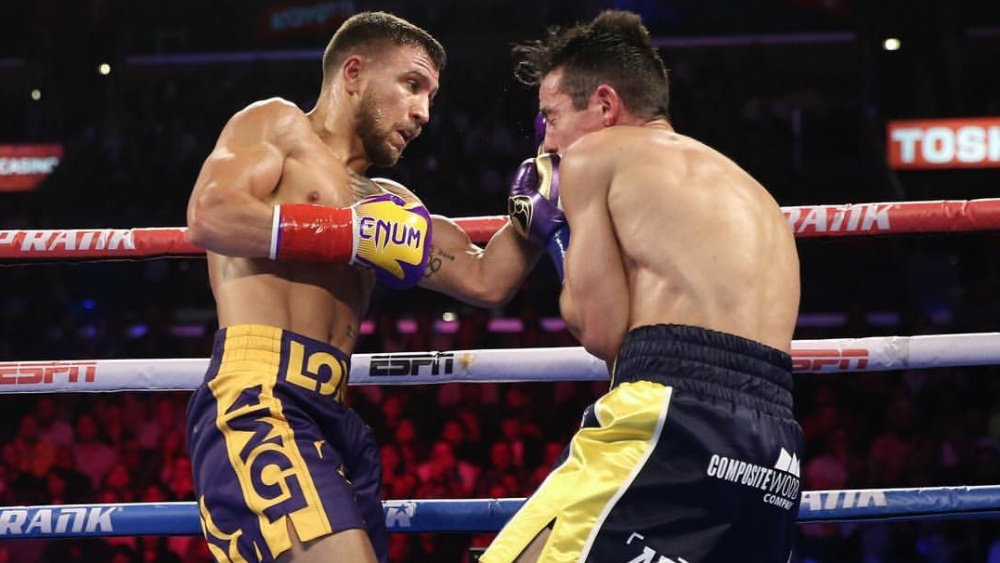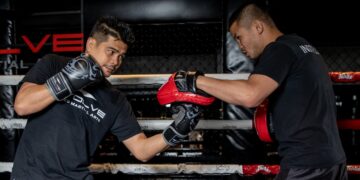
Although boxing has a myriad of styles, the pinnacle is the ability to hit without being hit. This is the essence of counterstriking, which focuses on making an opponent miss, and then dishing out punishment in return. Counterstriking is a cerebral approach to boxing, treating pugilism like a game of chess. A skilled counter striker has multiple ways to deal with their opponent’s every punch, sometimes throwing specific punches to bait a certain reaction. Today, Evolve Daily is pleased to share a guide on how to develop counterstriking for boxing.
Clean Technique
The first step in developing your counter-striking ability is to drill a clean boxing technique. Correct punching form will allow your counter punches to strike with power, as well as prevent your opponents from predicting you and hitting you with their counters. Drilling textbook boxing form will also create the shortest distance between your fists and your target, increasing your speed.
Perfect form in boxing comes from combining multiple aspects of punching such as hip drive, hip rotation, turning your punches over, and staying balanced with a tight core. Turning your punches over refers to the inward rotation of your knuckles and wrists at the very end of any straight punch. This has multiple purposes and is crucial for any boxer to learn, regardless of their individual boxing style. The rotation of the wrists puts your index and middle knuckles in line to make contact, maximizing damage to your opponent and minimizing damage to your own hand. This action also prevents elbow flare, which is detrimental to the effectiveness of your boxing overall. Elbow flare is when your elbows pop out of your frame, and can telegraph the timing of your punch. It also makes it easier for your opponents to block or parry your punch, as well as putting you in danger of hyperextending your elbow if you miss. Turning your punch over locks your elbow before hyperextension, giving you the confidence to throw full-power punches without the risk of injuring yourself. You are also able to punch in a straight line, between your opponent’s gloves, instead of striking from a less favorable angle. Because your punch is now coming at your opponent in a straight line, without any telegraph of its timing, turning your punches over makes blocking, parrying, or evading your punches more difficult for your opponent.
Hip drive is where the majority of your punching power originates. It is the action of pushing your entire body forwards or backwards and allows you to put your full weight into a punch. This is one of the reasons why heavyweights hit so much harder than flyweights, they simply have more mass to drive forwards with.
Hip rotation is turning your hips over to align with your shoulder and wrist. This maximizes the energy transfer of the kinetic chain and contributes to the snap of a punch. Every punch should start with hip drive, which begins the weight transfer; the last part of the punch is where you rotate your hips and turn your punch over, which gives it a burst of acceleration at the end. Facing a mirror when you punch is an easy way to check if you are turning your punches over at the correct time and can help you see if your timing for the hip drive and rotation are correct. Above is a video of Coach Trevor Wittman and Justin Gaethje explaining and demonstrating these concepts in depth.
Footwork
Training smooth, fluid footwork is the next key step to developing counterstriking for boxing. The purpose of footwork is to control distance and put you in a position to land punches while taking away those same opportunities from your opponent. The type of footwork you train most will depend on your boxing style and what range you prefer to fight from. For example, if you are a tall boxer with long limbs, boxing from the outside suits your natural physical advantages. You don’t have to brawl with your opponent shoulder to shoulder; your physique lends itself to using long straight punches and circling footwork to keep your opponent at arm’s reach. Taller fighters are often lighter on their feet and avoid planting their heels to stay mobile. Eastern European boxers are often taller with long limbs and their footwork reflects this. They use a more bladed stance and use pendulum steps, along with lateral skips, to shut an opponent down with their jab from the outside, waiting for an opportunity to land a hard cross. Vasiliy Lomachenko and Oleksandr Usyk are prime examples of elusive outboxers that utilize pendulum steps and lateral movement.
In contrast, boxers who aim for knockouts prefer to fight on the inside, right in the pocket. Instead of pendulum steps and lateral skips, infighters use stepping, shifting, and even stance-switching footwork to gain a positional advantage over their opponents. Manny Pacquiao would often take advantage of the angles provided by an open stance matchup, and throw his famous split entry cross. This is where he threw a left cross down his opponent’s centerline as he stepped to his right while slipping to evade a jab. Since the jab is the cornerstone of many boxers’ entire fight game, he was able to stifle his opponents by taking away one of their most important weapons.
Pacquiao would also step through into an orthodox stance after he threw his cross to increase the power of his subsequent lead-hand punch. Although switching stances has historically been frowned upon in many boxing gyms, Pacquiao used it to catch many opponents off guard, closing the gap faster than they anticipated.
Terrance “Bud” Crawford is another fighter who uses switching stances to increase their ability to counterstrike. Although he initially started as an orthodox stance boxer, Crawford trained his southpaw stance equally. This gave him the ability to completely switch stances mid-fight. Doing this would often throw his opponents off completely, as they had spent the majority of the fight adapting to the attacks and angles created by his orthodox stance. In his recent victory over Errol Spence Jr., Crawford made the intentional choice to fight as a southpaw. His ability to switch stances threw Spence off of his game and allowed Crawford to counterpunch his way to a knockout victory.
Double End Bag
The double-end bag is one of the best tools for developing counterstriking. Unlike other punching bags, the double-end bag moves, forcing you to be accurate while evading or blocking return fire. The double-end bag can be used for practice timing for specific counter punches and to improve your general conditioning for boxing. Although the double-end bag is great for increasing your speed, it is for learning to time your punches. Proper timing will beat speed, and create power. Timing is the primary aspect of effective counterpunching. Even if you are lighting quick, and hit as hard as a truck, your counters will be unsuccessful unless you can time them with the gaps in your opponent’s defense. Below are some basic double-end drills for those of you familiar with the number system in boxing. All drills below assume both you and your opponent are in an orthodox stance, creating a closed stance matchup.
- 1 = jab, 2 = cross, 3 = lead hook, 4 = rear hook, 5 = lead uppercut, 6 = rear uppercut
- 1 – Parry/catch with rear hand – 1
- 1 – slip toward rear side – 2
- 1 – slip toward lead side – 5
- 1 – slip toward lead side – 3
- 1 – 2 – weave towards rear side – 2 – 3
- 1 – 2 – rear cross arm block – 3
- 1 – 2 – lead shoulder roll – 2
- 1 – 2 – 5 – 2 – weave towards rear side – 2 – 3 – 2
These are basic drills that have you punching, avoiding your opponent’s return fire, and then countering. Above is a video of other drills that will help you adapt to the double-end bag.
Conclusion
Counterstriking for boxing is an extensive subject, the guide above only scratches the surface. Although it takes many hours of training to develop basic counterstriking, once learned, it will elevate your boxing immensely. Add the methods discussed above to your training and try some of the counters in your next sparring session!
You may also like:
Is Jake Paul A Legitimate Boxer?
These Are The Essential Drills To Improve Your Shadowboxing Technique
Hey there, boxing enthusiasts! You already know that footwork is the cornerstone of boxing. Good footwork is a tool that enhances your defense and offense, and it’s what sets the greats apart from the good….
At its core, boxing is a simple sport where participants aim to land more punches than their opponents in hopes of eventually securing a knockout blow or winning the bout via decision. Casual observers often…
Mastering various punches is key to your success in the boxing ring. You don’t have to master them all, but having a dozen or so punches you’ve perfected gives you an edge inside the ring….
Francis Ngannou shocked the world when he squared off against Tyson Fury in 2023, knocking boxing’s undisputed champion down in the third round and putting on a much better performance than most fans and pundits…
Boxing is one of the most effective martial arts disciplines for both training and self-defense. It is the art of pugilism, or the science of ‘hitting while not getting hit.’ It’s an all-around, engaging, and…
The heavyweight division in boxing has always been regarded as the most prestigious category in the sport. Heavyweight champions often become the face of boxing during their reigns, and the greatest champions earn global adoration. …
Muscle fatigue is a phenomenon familiar to athletes, fitness enthusiasts, and anyone who engages in physical activities like martial arts training. It’s the decline in the ability of a muscle to generate force, often experienced…
In Muay Thai, you need to have power in your kicks and knees if you want to dominate in the ring. Unlike other striking sports where the volume of shots landed plays a major role…
Nicolas Meregali is considered by many to be the current best active Brazilian Jiu-Jitsu competitor. According to Gordon Ryan, Meregali is only getting more advanced and farther in his grappling skills, making it harder for…
The Southpaw stance is the standard stance for left-handed fighters in mixed martial arts, but that doesn’t mean right-handed fighters shouldn’t use it to give themselves strategic advantages. Saying a fighter is in a southpaw…
More than ever, it is important for women to be able to defend themselves in a self-defense situation. Although it is always best to disengage and avoid any situation, there may be a time when…
Every workplace could benefit from strong, cohesive teams that work like well-oiled machines. These are the kind of teams that do plenty for the longevity, performance, and financial health of a company. However, the process…
































